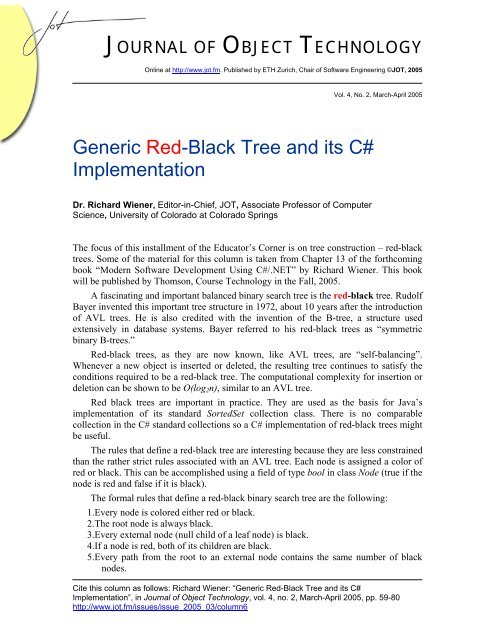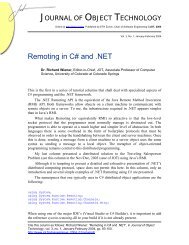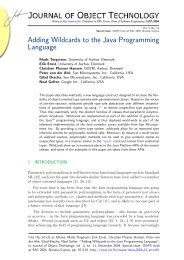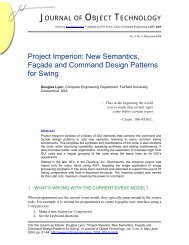Generic Red-Black Tree and its C# Implementation - The Journal of ...
Generic Red-Black Tree and its C# Implementation - The Journal of ...
Generic Red-Black Tree and its C# Implementation - The Journal of ...
You also want an ePaper? Increase the reach of your titles
YUMPU automatically turns print PDFs into web optimized ePapers that Google loves.
JOURNAL OF OBJECT TECHNOLOGYOnline at http://www.jot.fm. Published by ETH Zurich, Chair <strong>of</strong> S<strong>of</strong>tware Engineering ©JOT, 2005Vol. 4, No. 2, March-April 2005<strong>Generic</strong> <strong>Red</strong>-<strong>Black</strong> <strong>Tree</strong> <strong>and</strong> <strong>its</strong> <strong>C#</strong><strong>Implementation</strong>Dr. Richard Wiener, Editor-in-Chief, JOT, Associate Pr<strong>of</strong>essor <strong>of</strong> ComputerScience, University <strong>of</strong> Colorado at Colorado Springs<strong>The</strong> focus <strong>of</strong> this installment <strong>of</strong> the Educator’s Corner is on tree construction – red-blacktrees. Some <strong>of</strong> the material for this column is taken from Chapter 13 <strong>of</strong> the forthcomingbook “Modern S<strong>of</strong>tware Development Using <strong>C#</strong>/.NET” by Richard Wiener. This bookwill be published by Thomson, Course Technology in the Fall, 2005.A fascinating <strong>and</strong> important balanced binary search tree is the red-black tree. RudolfBayer invented this important tree structure in 1972, about 10 years after the introduction<strong>of</strong> AVL trees. He is also credited with the invention <strong>of</strong> the B-tree, a structure usedextensively in database systems. Bayer referred to his red-black trees as “symmetricbinary B-trees.”<strong>Red</strong>-black trees, as they are now known, like AVL trees, are “self-balancing”.Whenever a new object is inserted or deleted, the resulting tree continues to satisfy theconditions required to be a red-black tree. <strong>The</strong> computational complexity for insertion ordeletion can be shown to be O(log 2 n), similar to an AVL tree.<strong>Red</strong> black trees are important in practice. <strong>The</strong>y are used as the basis for Java’simplementation <strong>of</strong> <strong>its</strong> st<strong>and</strong>ard SortedSet collection class. <strong>The</strong>re is no comparablecollection in the <strong>C#</strong> st<strong>and</strong>ard collections so a <strong>C#</strong> implementation <strong>of</strong> red-black trees mightbe useful.<strong>The</strong> rules that define a red-black tree are interesting because they are less constrainedthan the rather strict rules associated with an AVL tree. Each node is assigned a color <strong>of</strong>red or black. This can be accomplished using a field <strong>of</strong> type bool in class Node (true if thenode is red <strong>and</strong> false if it is black).<strong>The</strong> formal rules that define a red-black binary search tree are the following:1. Every node is colored either red or black.2. <strong>The</strong> root node is always black.3. Every external node (null child <strong>of</strong> a leaf node) is black.4. If a node is red, both <strong>of</strong> <strong>its</strong> children are black.5. Every path from the root to an external node contains the same number <strong>of</strong> blacknodes.Cite this column as follows: Richard Wiener: “<strong>Generic</strong> <strong>Red</strong>-<strong>Black</strong> <strong>Tree</strong> <strong>and</strong> <strong>its</strong> <strong>C#</strong><strong>Implementation</strong>”, in <strong>Journal</strong> <strong>of</strong> Object Technology, vol. 4, no. 2, March-April 2005, pp. 59-80http://www.jot.fm/issues/issue_2005_03/column6
GENERIC RED-BLACK TREE AND ITS <strong>C#</strong> IMPLEMENTATIONIt is rule 5 that leads to a balanced tree structure. Since red nodes may not have any redchildren, if the black height from root to every leaf node is the same, this implies that anytwo paths from root to leaf can differ only by a factor <strong>of</strong> two. Using a relatively simplepro<strong>of</strong> <strong>of</strong> mathematical induction, Kenneth Berman <strong>and</strong> Jerome Paul show on page 659 <strong>of</strong>their book, Algorithms: Sequential, Parallel, <strong>and</strong> Distributed, Thomson, CourseTechnology, 2005, that the relationship between the maximum depth <strong>of</strong> a red-black tree<strong>and</strong> the number <strong>of</strong> internal nodes is, depth = 2 log 2 (n + 1) where n is the number <strong>of</strong>internal nodes.Let us consider some examples <strong>of</strong> red-black trees in Figure 1.<strong>The</strong> first red-black tree has a black depth <strong>of</strong> 2 from the root to every leaf node. <strong>The</strong>second red-black tree has a black depth <strong>of</strong> 3 from the root to every leaf node. Each <strong>of</strong>these trees is generated by a search tree GUI application (to be the subject <strong>of</strong> a futurecolumn).Figure 1 – Two Examples <strong>of</strong> <strong>Red</strong>-<strong>Black</strong> <strong>Tree</strong>s<strong>The</strong> algorithms for insertion <strong>and</strong> deletion involve node rotations as well as node recoloring.<strong>The</strong> algorithms with examples <strong>of</strong> insertion <strong>and</strong> deletion are presented first. Followingthis a complete implementation <strong>of</strong> class <strong>Red</strong><strong>Black</strong><strong>Tree</strong> is presented that includes all theimplementation details for insertion <strong>and</strong> deletion.60 JOURNAL OF OBJECT TECHNOLOGY VOL. 4, NO. 2
Mechanism for insertion into a red-black treePerform an ordinary binary search tree insertion into the red-black tree. If the path fromroot to the new leaf node that contains the information being inserted passes through anode that contains two red children, re-color these nodes black <strong>and</strong> re-color the node withthe two previously red children black, assuming that it is not the root node (if it is, leavethe node black since the root node <strong>of</strong> a red-black tree must be black).Color the new leaf node just inserted red.If the steps above lead to a succession <strong>of</strong> two red nodes in moving from the rootdown the tree, a rotational correction is needed. <strong>The</strong>re are four possible rotations that arepossible. Two <strong>of</strong> these are illustrated in Figures 2(a), (b). <strong>The</strong> other two are mirrorimages.Left rotate on N2 <strong>and</strong> color N1 red <strong>and</strong> N2 black.Figure 2a – Rotational <strong>and</strong> Recolor CorrectionVOL. 4, NO. 2 JOURNAL OF OBJECT TECHNOLOGY 61
GENERIC RED-BLACK TREE AND ITS <strong>C#</strong> IMPLEMENTATIONFigure 2b – Rotational <strong>and</strong> Recolor CorrectionRight-rotate on N2 then left-rotate on N3 <strong>and</strong> perform appropriate re-coloring (details tobe provided later).Consider the sequence <strong>of</strong> insertions shown in Figure 3. After each insertion, the newred-black tree is displayed.When node 50 is added, the search path passes through node 200 that contains twored nodes. This causes these nodes to be re-colored black.After node 250 is added, the insertion <strong>of</strong> 275 causes the rotation <strong>and</strong> re-coloringshown in Figure 3d. After inserting 280, the final tree is shown in Figure 3e. No rotationsare required.Figure 3a – Initial <strong>Red</strong>-<strong>Black</strong> <strong>Tree</strong>Figure 3b – <strong>Red</strong>-<strong>Black</strong> <strong>Tree</strong> After Inserting 5062 JOURNAL OF OBJECT TECHNOLOGY VOL. 4, NO. 2
Figure 3c – <strong>Red</strong>-<strong>Black</strong> <strong>Tree</strong> After Inserting 250Figure 3d – <strong>Red</strong>-<strong>Black</strong> <strong>Tree</strong> After Inserting 275Figure 3e – <strong>Red</strong>-<strong>Black</strong> <strong>Tree</strong> After Inserting 280Mechanism for deletion from a red-black tree<strong>The</strong> algorithm for deletion is more complex than the algorithm for insertion. <strong>The</strong>re areseven special cases to consider.<strong>The</strong> first step is to perform an ordinary binary search tree deletion. In the case wherethe node being deleted has two children, we copy the value but not the color <strong>of</strong> the inordersuccessor. <strong>The</strong>n we delete the in-order successor, a node that can have at most onechild.If the node being deleted is colored red, no further corrections are needed. If thedeleted node is black <strong>and</strong> it has a red right child, the red right child is re-colored to black<strong>and</strong> this serves to restore the tree to red-black status.VOL. 4, NO. 2 JOURNAL OF OBJECT TECHNOLOGY 63
State 3(Same diagram as state 1)Change color <strong>of</strong> sibling to red <strong>and</strong> <strong>its</strong> left child to black <strong>and</strong> then right rotate on sibling.Make transition to case 4.State 4(Same diagram as state1)Change color <strong>of</strong> sibling’s right child to black, make parent black, color sibling the color<strong>of</strong> parent <strong>and</strong> then left rotate on parent <strong>and</strong> end.Several examples are presented that demonstrate some <strong>of</strong> the cases defined above.Consider the tree shown below. We wish to delete node 250. <strong>The</strong> right child <strong>of</strong> 250is null so the Current Node is null. Its parent is 225 (after the deletion when the left child<strong>of</strong> 350 becomes 225) <strong>and</strong> <strong>its</strong> sibling is null. Since <strong>its</strong> parent is colored red, the systemgoes from the start state to state 2b.This leads to the result shown below in which the color <strong>of</strong> 225 is changed to black.Consider the deletion <strong>of</strong> 250 from the following tree:VOL. 4, NO. 2 JOURNAL OF OBJECT TECHNOLOGY 65
GENERIC RED-BLACK TREE AND ITS <strong>C#</strong> IMPLEMENTATION<strong>The</strong> table <strong>of</strong> states given above suggests that from the start state a transition to state 3’occurs. <strong>The</strong> Current Node is null, <strong>its</strong> parent is 247, <strong>its</strong> sibling is 225 <strong>and</strong> <strong>its</strong> sibling’s rightchild is red. <strong>The</strong>se are the conditions needed for state 3’. After the node re-coloringindicated under state 3’ above, a left rotate is done on the sibling node 225. A transitionto state 4’ occurs. After more re-coloring, a right rotate on node 247 brings red node 230to the left <strong>of</strong> 350. <strong>The</strong> tree resulting from states 3’ <strong>and</strong> 4’ is shown below.Consider the deletion <strong>of</strong> node 77 from the following red-black tree:From the start state a transition is made to state 2a since the parent, node 182, is black,the sibling, 190 is black <strong>and</strong> the children <strong>of</strong> the sibling (null) are black.66 JOURNAL OF OBJECT TECHNOLOGY VOL. 4, NO. 2
From state 2a a transition is made to state 3 <strong>and</strong> then state 4. <strong>The</strong> final tree after thesethree states is shown below.Unless one studies these transitions carefully, it simply looks like magic.As the final example consider the deletion <strong>of</strong> node 225 from the following red-blacktree:From the start state a transition to state 1 occurs. This is because the sibling, node 370, isred <strong>and</strong> the parent, node 247 is black.Two Alternative Designs <strong>of</strong> <strong>Red</strong>-<strong>Black</strong> <strong>Tree</strong>s<strong>The</strong> algorithm for insertion requires that the ancestors (parent, gr<strong>and</strong> parent, great gr<strong>and</strong>parent) <strong>of</strong> the inserted node be available. <strong>The</strong> implementation <strong>of</strong> deletion requires that theparent, sibling <strong>and</strong> gr<strong>and</strong>parent nodes be available from the node being deleted. Thisleads to an important implementation question: should each node <strong>of</strong> a red-black tree havea link “pointing” to <strong>its</strong> parent (the root would link to a parent <strong>of</strong> null)? <strong>The</strong> alternative isto stay with the same structure as used in the implementation <strong>of</strong> the binary search tree <strong>and</strong>AVL tree in which each node is linked to <strong>its</strong> two children <strong>and</strong> not to <strong>its</strong> parent. <strong>The</strong>trade<strong>of</strong>f is replacing more complexity in the basic operations <strong>of</strong> insertion <strong>and</strong> deletionwith easier implementations <strong>of</strong> the various rotational <strong>and</strong> re-coloring “corrections”related to insertion <strong>and</strong> deletion.<strong>The</strong> decision is to use the more complex node structure in which each node containsa link to <strong>its</strong> parent node since this leads to the most efficient implementation <strong>of</strong> the red-VOL. 4, NO. 2 JOURNAL OF OBJECT TECHNOLOGY 67
GENERIC RED-BLACK TREE AND ITS <strong>C#</strong> IMPLEMENTATIONblack tree, particularly for deletion. An implementation that does not use links from childto parent requires a field, stack, <strong>and</strong> recursive ConstructStack method whose purpose is todetermine the nodes in the path from root to any specified node. Because <strong>of</strong> the need t<strong>of</strong>requently invoke this method, the implementation for deletion is 100 times slower thanan AVL tree with the same node values. This is unacceptable <strong>and</strong> leads to the focus onthe version that contains links from child to parent nodes.Comparing performance <strong>of</strong> binary search trees<strong>The</strong> results <strong>of</strong> a simulation that compares the execution time required for inserting asequence <strong>of</strong> values <strong>and</strong> later removing them from an unbalanced binary search tree, anAVL tree <strong>and</strong> a <strong>Red</strong>-<strong>Black</strong> tree are presented first. <strong>The</strong> two types <strong>of</strong> red-black treeimplementations, with <strong>and</strong> without links to parent nodes, are included in the table eventhough only the implementation <strong>of</strong> the version with links to parent nodes will bepresented. An ascending sequence <strong>of</strong> integers <strong>of</strong> size shown is used to construct each tree.<strong>The</strong>n all the values that were used to construct the tree are used in a sequence <strong>of</strong>deletions.<strong>Tree</strong> Type Number Nodes Time forInsertionTime for Deletion ACE Value <strong>of</strong><strong>Tree</strong>Binary Search 10,000 34.48 seconds 5000.5<strong>Tree</strong><strong>Red</strong>-<strong>Black</strong> <strong>Tree</strong> 10,000 0.0312 seconds 2.844 seconds 12.88(No links toparent nodes)<strong>Red</strong>-<strong>Black</strong> <strong>Tree</strong> 10,000 0.0156 seconds 0.0156 seconds 12.88(Links from childto parent nodes)AVL <strong>Tree</strong> 10,000 0.0156 seconds 0.0156 seconds 12.36<strong>Red</strong>-<strong>Black</strong> <strong>Tree</strong> 1,000,000 3.609 1.0625 19.33(Links from childto parent nodes)AVL <strong>Tree</strong> 1,000,000 2.406 seconds 1.031 18.95It is clear from the table above that the performance <strong>of</strong> the red-black tree with each nodelinking to <strong>its</strong> parent is superior to the red-black tree without such links to parent nodes<strong>and</strong> comparable to the performance <strong>of</strong> the AVL tree.<strong>Implementation</strong> <strong>of</strong> class Node with upward links<strong>The</strong> details <strong>of</strong> class Node are presented in Listing 1. It is a nested class (similar to Java’sstatic inner class) in a generic class with parameter T (as seen later) so it does not require<strong>its</strong> own generic parameter.68 JOURNAL OF OBJECT TECHNOLOGY VOL. 4, NO. 2
Listing 1 – Class Nodeprivate class Node {// Fieldsprivate T item; // <strong>Generic</strong> object held by each nodeprivate Node left, right, parent; // Links to children <strong>and</strong> parentprivate bool red = true; // Color <strong>of</strong> node// Constructorpublic Node(T item, Node parent) {this.item = item;this.parent = parent;left = right = null;}// Propertiespublic Node Left {get {return left;}set {left = value;}}public Node Right {get {return right;}set {right = value;}}public Node Parent {get {return parent;}set {parent = value;}}}// Similar get/set properties for Item <strong>and</strong> <strong>Red</strong><strong>Tree</strong> rotation with upward links to parent nodes<strong>The</strong> methods LeftRotate <strong>and</strong> RightRotate must take the parent link into account. MethodLeftRotate is presented in Listing 2. Method RightRotate is the symmetrical opposite <strong>and</strong>not presented. <strong>The</strong> reference parameter capability <strong>of</strong> <strong>C#</strong> (ref parameter) is utilized in thetwo rotation methods. This allows explicit linking between the tree structure unaffectedby the rotation <strong>and</strong> the new node that is passed back through the reference parameter.VOL. 4, NO. 2 JOURNAL OF OBJECT TECHNOLOGY 69
GENERIC RED-BLACK TREE AND ITS <strong>C#</strong> IMPLEMENTATIONListing 2 – Revised methods LeftRotateprivate void LeftRotate(ref Node node) {Node nodeParent = node.Parent;Node right = node.Right;Node temp = right.Left;right.Left = node;node.Parent = right;node.Right = temp;if (temp != null) {temp.Parent = node;}if (right != null) {right.Parent = nodeParent;}node = right;}After setting the right child <strong>of</strong> ref variable node to temp, the parent <strong>of</strong> temp is set to node(if temp is not null). This reflects the new parent <strong>of</strong> temp after the rotation is completed.<strong>The</strong> parent <strong>of</strong> right is set to nodeParent, a local variable that is immediately assigned asthe first line in the method. This reflects the upward connection between the node beingpassed back (right) <strong>and</strong> <strong>its</strong> parent (not affected by the rotation). <strong>The</strong>se two assignmentsusing Parent ensure that the two links that are modified by the rotation are linked in bothdirections.<strong>Implementation</strong> <strong>of</strong> insertion<strong>The</strong> public method Add <strong>and</strong> <strong>its</strong> private support methods InsertNode, GetNodesAbove <strong>and</strong>Fix<strong>Tree</strong>AfterInsertion implement the red-black algorithm for insertion.<strong>The</strong>se methods are presented in Listing 3.Listing 3 – Methods that support insertion in a red-black treepublic void Add(T item) {root = InsertNode(root, item, null);numberElements++;if (numberElements > 2) {Node parent, gr<strong>and</strong>Parent, greatGr<strong>and</strong>Parent;GetNodesAbove(insertedNode, out parent,out gr<strong>and</strong>Parent, out greatGr<strong>and</strong>Parent);Fix<strong>Tree</strong>AfterInsertion(insertedNode, parent,gr<strong>and</strong>Parent, greatGr<strong>and</strong>Parent);}}private Node InsertNode(Node node, T item, Node parent) {if (node == null) {Node newNode = new Node(item, parent);if (numberElements > 0) {newNode.<strong>Red</strong> = true;} else {newNode.<strong>Red</strong> = false;}insertedNode = newNode;70 JOURNAL OF OBJECT TECHNOLOGY VOL. 4, NO. 2
}return newNode;} else if (item.CompareTo(node.Item) < 0) {node.Left = InsertNode(node.Left, item, node);return node;} else if (item.CompareTo(node.Item) > 0) {node.Right = InsertNode(node.Right, item, node);return node;} else {throw new InvalidOperationException("Cannot add duplicate object.");}private void GetNodesAbove(Node curNode, out Node parent,out Node gr<strong>and</strong>Parent,out Node greatGr<strong>and</strong>Parent) {parent = null;gr<strong>and</strong>Parent = null;greatGr<strong>and</strong>Parent = null;if (curNode != null) {parent = curNode.Parent;}if (parent != null) {gr<strong>and</strong>Parent = parent.Parent;}if (gr<strong>and</strong>Parent != null) {greatGr<strong>and</strong>Parent = gr<strong>and</strong>Parent.Parent;}}private void Fix<strong>Tree</strong>AfterInsertion(Node child, Node parent,Node gr<strong>and</strong>Parent,Node greatGr<strong>and</strong>Parent) {if (gr<strong>and</strong>Parent != null) {Node uncle = (gr<strong>and</strong>Parent.Right == parent) ?gr<strong>and</strong>Parent.Left : gr<strong>and</strong>Parent.Right;if (uncle != null && parent.<strong>Red</strong> && uncle.<strong>Red</strong>) {uncle.<strong>Red</strong> = false;parent.<strong>Red</strong> = false;gr<strong>and</strong>Parent.<strong>Red</strong> = true;Node higher = null;Node stillHigher = null;if (greatGr<strong>and</strong>Parent != null) {higher = greatGr<strong>and</strong>Parent.Parent;}if (higher != null) {stillHigher = higher.Parent;}Fix<strong>Tree</strong>AfterInsertion(gr<strong>and</strong>Parent, greatGr<strong>and</strong>Parent,higher, stillHigher);} else if (uncle == null || parent.<strong>Red</strong> && !uncle.<strong>Red</strong>) {if (gr<strong>and</strong>Parent.Right == parent &&parent.Right == child) { // right-right caseparent.<strong>Red</strong> = false;gr<strong>and</strong>Parent.<strong>Red</strong> = true;if (greatGr<strong>and</strong>Parent != null) {if (greatGr<strong>and</strong>Parent.Right == gr<strong>and</strong>Parent) {LeftRotate(ref gr<strong>and</strong>Parent);greatGr<strong>and</strong>Parent.Right = gr<strong>and</strong>Parent;} else {LeftRotate(ref gr<strong>and</strong>Parent);VOL. 4, NO. 2 JOURNAL OF OBJECT TECHNOLOGY 71
GENERIC RED-BLACK TREE AND ITS <strong>C#</strong> IMPLEMENTATION}}greatGr<strong>and</strong>Parent.Left = gr<strong>and</strong>Parent;}} else {LeftRotate(ref root);}} else if (gr<strong>and</strong>Parent.Left == parent &&parent.Left == child) { // left-left caseparent.<strong>Red</strong> = false;gr<strong>and</strong>Parent.<strong>Red</strong> = true;if (greatGr<strong>and</strong>Parent != null) {if (greatGr<strong>and</strong>Parent.Right == gr<strong>and</strong>Parent) {RightRotate(ref gr<strong>and</strong>Parent);greatGr<strong>and</strong>Parent.Right = gr<strong>and</strong>Parent;} else {RightRotate(ref gr<strong>and</strong>Parent);greatGr<strong>and</strong>Parent.Left = gr<strong>and</strong>Parent;}} else {RightRotate(ref root);}} else if (gr<strong>and</strong>Parent.Right == parent &&parent.Left == child) {// right-left casechild.<strong>Red</strong> = false;gr<strong>and</strong>Parent.<strong>Red</strong> = true;RightRotate(ref parent);gr<strong>and</strong>Parent.Right = parent;if (greatGr<strong>and</strong>Parent != null) {if (greatGr<strong>and</strong>Parent.Right == gr<strong>and</strong>Parent) {LeftRotate(ref gr<strong>and</strong>Parent);greatGr<strong>and</strong>Parent.Right = gr<strong>and</strong>Parent;} else {LeftRotate(ref gr<strong>and</strong>Parent);greatGr<strong>and</strong>Parent.Left = gr<strong>and</strong>Parent;}} else {LeftRotate(ref root);}} else if (gr<strong>and</strong>Parent.Left == parent &&parent.Right == child) {// left-right casechild.<strong>Red</strong> = false;gr<strong>and</strong>Parent.<strong>Red</strong> = true;LeftRotate(ref parent);gr<strong>and</strong>Parent.Left = parent;if (greatGr<strong>and</strong>Parent != null) {if (greatGr<strong>and</strong>Parent.Right == gr<strong>and</strong>Parent) {RightRotate(ref gr<strong>and</strong>Parent);greatGr<strong>and</strong>Parent.Right = gr<strong>and</strong>Parent;} else {RightRotate(ref gr<strong>and</strong>Parent);greatGr<strong>and</strong>Parent.Left = gr<strong>and</strong>Parent;}} else {RightRotate(ref root);}}}if (root.<strong>Red</strong>) {root.<strong>Red</strong> = false;}72 JOURNAL OF OBJECT TECHNOLOGY VOL. 4, NO. 2
<strong>The</strong> recursive InsertNode contains a parameter, parent, which allows node at one level <strong>of</strong>recursion to be passed as parent to the next lower level <strong>of</strong> recursion.<strong>The</strong> support method GetNodesAbove use the out parameter facility <strong>of</strong> <strong>C#</strong> to returnrelevant nodes above the current node (curNode). This can be easily accomplishedbecause <strong>of</strong> the upward links in the node structure.<strong>The</strong> important support method Fix<strong>Tree</strong>AfterInsertion with four nodes as inputimplements the details <strong>of</strong> the red-black insertion algorithm as outlined <strong>and</strong> illustratedabove. Care has been taken to use descriptive local variable <strong>and</strong> parameter names to makeit easier for the code to be self-documenting<strong>Implementation</strong> <strong>of</strong> deletion<strong>The</strong> implementation <strong>of</strong> deletion is more complex than the implementation <strong>of</strong> insertion.This reflects the additional complexity <strong>of</strong> the algorithm for deletion which as you haveseen earlier involves seven special cases <strong>and</strong> transitions from some <strong>of</strong> the cases to othercases. <strong>The</strong> remaining portion <strong>of</strong> class <strong>Red</strong><strong>Black</strong> that includes all the support for deletionis presented in Listing 4.<strong>The</strong> generic class uses a constrained generic parameter T where T implements theIComparable interface.Listing 4 – Remaining details <strong>of</strong> class <strong>Red</strong><strong>Black</strong><strong>Tree</strong>using System;using System.Collections.<strong>Generic</strong>;using System.Text;using System.Windows.Forms;namespace Search<strong>Tree</strong>s {public class <strong>Red</strong><strong>Black</strong><strong>Tree</strong> where T : IComparable {// Fieldsprivate Node root;private int numberElements;private Node insertedNode;private Node nodeBeingDeleted; // Set in DeleteNodeprivate bool siblingToRight; // Sibling <strong>of</strong> curNodeprivate bool parentToRight; // Of gr<strong>and</strong> parentprivate bool nodeToDelete<strong>Red</strong>; // Color <strong>of</strong> deleted node// Comm<strong>and</strong>spublic void Add(T item) {// Presented in previous listing}public void Remove(T item) {if (numberElements > 1) {root = DeleteNode(root, item, null);numberElements--;if (numberElements == 0) {root = null;VOL. 4, NO. 2 JOURNAL OF OBJECT TECHNOLOGY 73
GENERIC RED-BLACK TREE AND ITS <strong>C#</strong> IMPLEMENTATION}}}Node curNode = null; // Right node being deletedif (nodeBeingDeleted.Right != null) {curNode = nodeBeingDeleted.Right;}Node parent, sibling, gr<strong>and</strong>Parent;if (curNode == null) {parent = nodeBeingDeleted.Parent;} else {parent = curNode.Parent;}GetParentGr<strong>and</strong>ParentSibling(curNode, parent,out sibling, out gr<strong>and</strong>Parent);if (curNode != null && curNode.<strong>Red</strong>) {curNode.<strong>Red</strong> = false;} else if (!nodeToDelete<strong>Red</strong> && !nodeBeingDeleted.<strong>Red</strong>) {Fix<strong>Tree</strong>AfterDeletion(curNode, parent,sibling, gr<strong>and</strong>Parent);}root.<strong>Red</strong> = false;// Queriesprivate Node InsertNode(Node node, T item, Node parent) {// Presented in previous listing}private void RightRotate(ref Node node) {// Presented earlier}private void LeftRotate(ref Node node) {// Presented earlier}private void GetNodesAbove(Node curNode, out Node parent,out Node gr<strong>and</strong>Parent,out Node greatGr<strong>and</strong>Parent) {// Presented in previous listing}private void GetParentGr<strong>and</strong>ParentSibling(Node curNode,Node parent,out Node sibling, out Node gr<strong>and</strong>Parent) {sibling = null;gr<strong>and</strong>Parent = null;if (parent != null) {if (parent.Right == curNode) {siblingToRight = false;sibling = parent.Left;}if (parent.Left == curNode) {siblingToRight = true;sibling = parent.Right;}}if (parent != null) {gr<strong>and</strong>Parent = parent.Parent;74 JOURNAL OF OBJECT TECHNOLOGY VOL. 4, NO. 2
}}if (gr<strong>and</strong>Parent != null) {if (gr<strong>and</strong>Parent.Right == parent) {parentToRight = true;}if (gr<strong>and</strong>Parent.Left == parent) {parentToRight = false;}}private void Fix<strong>Tree</strong>AfterInsertion(Node child, Node parent,Node gr<strong>and</strong>Parent,Node greatGr<strong>and</strong>Parent) {// Presented in previous listing}private Node DeleteNode(Node node, T item, Node parent) {private Node DeleteNode(Node node, T item, Node parent) {if (node == null) {throw new InvalidOperationException("item not in search tree.");}if (item.CompareTo(node.Item) < 0) {node.Left = DeleteNode(node.Left, item, node);} else if (item.CompareTo(node.Item) > 0) {node.Right = DeleteNode(node.Right, item, node);} else if (item.CompareTo(node.Item) == 0) {// Item foundnodeToDelete<strong>Red</strong> = node.<strong>Red</strong>;nodeBeingDeleted = node;if (node.Left == null) {// No children or only a right childnode = node.Right;if (node != null) {node.Parent = parent;}} else if (node.Right == null) {// Only a left childnode = node.Left;node.Parent = parent;} else { // Two children// Deletes using the leftmost node <strong>of</strong> the// right subtreeT replaceWithValue = LeftMost(node.Right);node.Right =DeleteLeftMost(node.Right, node);node.Item = replaceWithValue;}}return node;}}private Node DeleteLeftMost(Node node, Node parent) {if (node.Left == null) {nodeBeingDeleted = node;if (node.Right != null) {node.Parent = parent;}return node.Right;VOL. 4, NO. 2 JOURNAL OF OBJECT TECHNOLOGY 75
GENERIC RED-BLACK TREE AND ITS <strong>C#</strong> IMPLEMENTATION}} else {node.Left = DeleteLeftMost(node.Left, node);return node;}private T LeftMost(Node node) {if (node.Left == null) {return node.Item;} else {return LeftMost(node.Left);}}private void Fix<strong>Tree</strong>AfterDeletion(Node curNode, Node parent,Node sibling, Node gr<strong>and</strong>Parent) {Node siblingLeftChild = null;Node siblingRightChild = null;if (sibling != null && sibling.Left != null) {siblingLeftChild = sibling.Left;}if (sibling != null && sibling.Right != null) {siblingRightChild = sibling.Right;}bool sibling<strong>Red</strong> = (sibling != null && sibling.<strong>Red</strong>);bool siblingLeft<strong>Red</strong> = (siblingLeftChild != null&& siblingLeftChild.<strong>Red</strong>);bool siblingRight<strong>Red</strong> = (siblingRightChild != null &&siblingRightChild.<strong>Red</strong>);}if (parent != null && !parent.<strong>Red</strong> && sibling<strong>Red</strong> &&!siblingLeft<strong>Red</strong> && !siblingRight<strong>Red</strong>) {Case1(curNode, parent, sibling, gr<strong>and</strong>Parent);} else if (parent != null && !parent.<strong>Red</strong> &&!sibling<strong>Red</strong> && !siblingLeft<strong>Red</strong> && !siblingRight<strong>Red</strong>) {Case2A(curNode, parent, sibling, gr<strong>and</strong>Parent);} else if (parent != null && parent.<strong>Red</strong> &&!sibling<strong>Red</strong> && !siblingLeft<strong>Red</strong> && !siblingRight<strong>Red</strong>) {Case2B(curNode, parent, sibling, gr<strong>and</strong>Parent);} else if (siblingToRight && !sibling<strong>Red</strong> &&siblingLeft<strong>Red</strong> && !siblingRight<strong>Red</strong>) {Case3(curNode, parent, sibling, gr<strong>and</strong>Parent);} else if (!siblingToRight &&!sibling<strong>Red</strong> && !siblingLeft<strong>Red</strong> && siblingRight<strong>Red</strong>) {Case3P(curNode, parent, sibling, gr<strong>and</strong>Parent);} else if (siblingToRight && !sibling<strong>Red</strong> &&siblingRight<strong>Red</strong>) {Case4(curNode, parent, sibling, gr<strong>and</strong>Parent);} else if (!siblingToRight && !sibling<strong>Red</strong> &&siblingLeft<strong>Red</strong>) {Case4P(curNode, parent, sibling, gr<strong>and</strong>Parent);}private void Case1(Node curNode, Node parent,Node sibling, Node gr<strong>and</strong>Parent) {if (siblingToRight) {parent.<strong>Red</strong> = !parent.<strong>Red</strong>;sibling.<strong>Red</strong> = !sibling.<strong>Red</strong>;if (gr<strong>and</strong>Parent != null) {if (parentToRight) {76 JOURNAL OF OBJECT TECHNOLOGY VOL. 4, NO. 2
LeftRotate(ref parent);gr<strong>and</strong>Parent.Right = parent;} else if (!parentToRight) {LeftRotate(ref parent);gr<strong>and</strong>Parent.Left = parent;}} else {LeftRotate(ref parent);root = parent;}gr<strong>and</strong>Parent = sibling;parent = parent.Left;parentToRight = false;} else if (!siblingToRight) {parent.<strong>Red</strong> = !parent.<strong>Red</strong>;sibling.<strong>Red</strong> = !sibling.<strong>Red</strong>;if (gr<strong>and</strong>Parent != null) {if (parentToRight) {RightRotate(ref parent);gr<strong>and</strong>Parent.Right = parent;} else if (!parentToRight) {RightRotate(ref parent);gr<strong>and</strong>Parent.Left = parent;}} else {RightRotate(ref parent);root = parent;}gr<strong>and</strong>Parent = sibling;parent = parent.Right;parentToRight = true;}if (parent.Right == curNode) {sibling = parent.Left;siblingToRight = false;} else if (parent.Left == curNode) {sibling = parent.Right;siblingToRight = true;}Node siblingLeftChild = null;Node siblingRightChild = null;if (sibling != null && sibling.Left != null) {siblingLeftChild = sibling.Left;}if (sibling != null && sibling.Right != null) {siblingRightChild = sibling.Right;}bool sibling<strong>Red</strong> = (sibling != null && sibling.<strong>Red</strong>);bool siblingLeft<strong>Red</strong> = (siblingLeftChild != null &&siblingLeftChild.<strong>Red</strong>);bool siblingRight<strong>Red</strong> = (siblingRightChild != null &&siblingRightChild.<strong>Red</strong>);if (parent.<strong>Red</strong> && !sibling<strong>Red</strong> && !siblingLeft<strong>Red</strong> &&!siblingRight<strong>Red</strong>) {Case2B(curNode, parent, sibling, gr<strong>and</strong>Parent);} else if (siblingToRight && !sibling<strong>Red</strong> && siblingLeft<strong>Red</strong>&& !siblingRight<strong>Red</strong>) {Case3(curNode, parent, sibling, gr<strong>and</strong>Parent);VOL. 4, NO. 2 JOURNAL OF OBJECT TECHNOLOGY 77
GENERIC RED-BLACK TREE AND ITS <strong>C#</strong> IMPLEMENTATION}} else if (!siblingToRight && !sibling<strong>Red</strong> &&!siblingLeft<strong>Red</strong> && siblingRight<strong>Red</strong>) {Case3P(curNode, parent, sibling, gr<strong>and</strong>Parent);} else if (siblingToRight && !sibling<strong>Red</strong> &&siblingRight<strong>Red</strong>) {Case4(curNode, parent, sibling, gr<strong>and</strong>Parent);} else if (!siblingToRight && !sibling<strong>Red</strong> &&siblingLeft<strong>Red</strong>) {Case4P(curNode, parent, sibling, gr<strong>and</strong>Parent);}private void Case2A(Node curNode, Node parent,Node sibling, Node gr<strong>and</strong>Parent) {if (sibling != null) {sibling.<strong>Red</strong> = !sibling.<strong>Red</strong>;}curNode = parent;if (curNode != root) {parent = curNode.Parent;GetParentGr<strong>and</strong>ParentSibling(curNode, parent,out sibling, out gr<strong>and</strong>Parent);Node siblingLeftChild = null;Node siblingRightChild = null;if (sibling != null && sibling.Left != null) {siblingLeftChild = sibling.Left;}if (sibling != null && sibling.Right != null) {siblingRightChild = sibling.Right;}bool sibling<strong>Red</strong> = (sibling != null && sibling.<strong>Red</strong>);bool siblingLeft<strong>Red</strong> = (siblingLeftChild != null &&siblingLeftChild.<strong>Red</strong>);}}boolsiblingRight<strong>Red</strong> = (siblingRightChild != null &&siblingRightChild.<strong>Red</strong>);if (parent != null && !parent.<strong>Red</strong> && !sibling<strong>Red</strong> &&!siblingLeft<strong>Red</strong> && !siblingRight<strong>Red</strong>) {Case2A(curNode, parent, sibling, gr<strong>and</strong>Parent);} else if (parent != null && parent.<strong>Red</strong> && !sibling<strong>Red</strong>&& !siblingLeft<strong>Red</strong> && !siblingRight<strong>Red</strong>) {Case2B(curNode, parent, sibling, gr<strong>and</strong>Parent);} else if (siblingToRight && !sibling<strong>Red</strong> &&siblingLeft<strong>Red</strong> && !siblingRight<strong>Red</strong>) {Case3(curNode, parent, sibling, gr<strong>and</strong>Parent);} else if (!siblingToRight && !sibling<strong>Red</strong> &&!siblingLeft<strong>Red</strong> && siblingRight<strong>Red</strong>) {Case3P(curNode, parent, sibling, gr<strong>and</strong>Parent);} else if (siblingToRight && !sibling<strong>Red</strong> &&siblingRight<strong>Red</strong>) {Case4(curNode, parent, sibling, gr<strong>and</strong>Parent);} else if (!siblingToRight && !sibling<strong>Red</strong> &&siblingLeft<strong>Red</strong>) {Case4P(curNode, parent, sibling, gr<strong>and</strong>Parent);}private void Case2B(Node curNode, Node parent,Node sibling, Node gr<strong>and</strong>Parent) {if (sibling != null) {sibling.<strong>Red</strong> = !sibling.<strong>Red</strong>;78 JOURNAL OF OBJECT TECHNOLOGY VOL. 4, NO. 2
}}curNode = parent;curNode.<strong>Red</strong> = !curNode.<strong>Red</strong>;private void Case3(Node curNode, Node parent,Node sibling, Node gr<strong>and</strong>Parent) {if (parent.Left == curNode) {sibling.<strong>Red</strong> = true;sibling.Left.<strong>Red</strong> = false;RightRotate(ref sibling);parent.Right = sibling;}Case4(curNode, parent, sibling, gr<strong>and</strong>Parent);}private void Case3P(Node curNode, Node parent,Node sibling, Node gr<strong>and</strong>Parent) {if (parent.Right == curNode) {sibling.<strong>Red</strong> = true;sibling.Right.<strong>Red</strong> = false;LeftRotate(ref sibling);parent.Left = sibling;}Case4P(curNode, parent, sibling, gr<strong>and</strong>Parent);}private void Case4(Node curNode, Node parent,Node sibling, Node gr<strong>and</strong>Parent) {sibling.<strong>Red</strong> = parent.<strong>Red</strong>;sibling.Right.<strong>Red</strong> = false;parent.<strong>Red</strong> = false;if (gr<strong>and</strong>Parent != null) {if (parentToRight) {LeftRotate(ref parent);gr<strong>and</strong>Parent.Right = parent;} else {LeftRotate(ref parent);gr<strong>and</strong>Parent.Left = parent;}} else {LeftRotate(ref parent);root = parent;}}private void Case4P(Node curNode, Node parent,Node sibling, Node gr<strong>and</strong>Parent) {sibling.<strong>Red</strong> = parent.<strong>Red</strong>;sibling.Left.<strong>Red</strong> = false;parent.<strong>Red</strong> = false;if (gr<strong>and</strong>Parent != null) {if (parentToRight) {RightRotate(ref parent);gr<strong>and</strong>Parent.Right = parent;} else {RightRotate(ref parent);gr<strong>and</strong>Parent.Left = parent;}} else {RightRotate(ref parent);VOL. 4, NO. 2 JOURNAL OF OBJECT TECHNOLOGY 79
GENERIC RED-BLACK TREE AND ITS <strong>C#</strong> IMPLEMENTATION}}root = parent;}}private class Node {// Details presented earlier}Care was again taken in choosing variable <strong>and</strong> parameter names so that the code wouldbe self-documenting. <strong>The</strong> complexity <strong>of</strong> the code reflects the complexity <strong>of</strong> the algorithmfor deletion.<strong>C#</strong>’s requirement that ref or out parameters must be explicitly tagged when invokinga method is desirable. It makes the semantics <strong>of</strong> the method invocation clear withoutrequiring the programmer to refer back to the method signature. <strong>The</strong>re are manyexamples <strong>of</strong> such method invocations in Listing 4.In a future column, a GUI application that renders a graphical depiction <strong>of</strong> searchtrees as values are inserted in or deleted from ordinary binary search trees, AVL trees <strong>and</strong>red-black trees is presented. This GUI application was used as a test-bed whiledeveloping the code presented in this paper.About the authorRichard Wiener is Associate Pr<strong>of</strong>essor <strong>of</strong> Computer Science at theUniversity <strong>of</strong> Colorado at Colorado Springs. He is also the Editor-in-Chief <strong>of</strong> JOT <strong>and</strong> former Editor-in-Chief <strong>of</strong> the <strong>Journal</strong> <strong>of</strong> ObjectOriented Programming. In addition to University work, Dr. Wiener hasauthored or co-authored 21 books <strong>and</strong> works actively as a consultant<strong>and</strong> s<strong>of</strong>tware contractor whenever the possibility arises.80 JOURNAL OF OBJECT TECHNOLOGY VOL. 4, NO. 2












